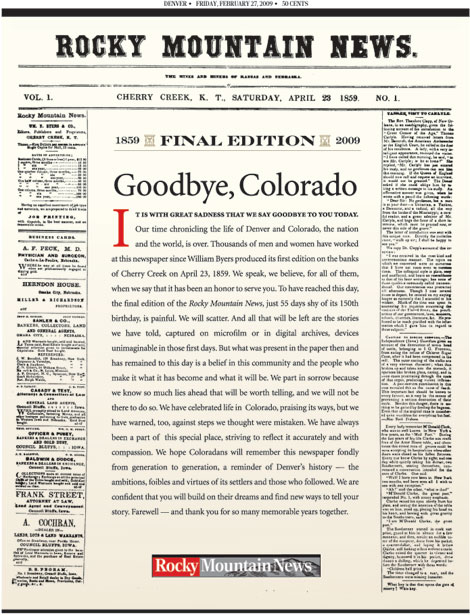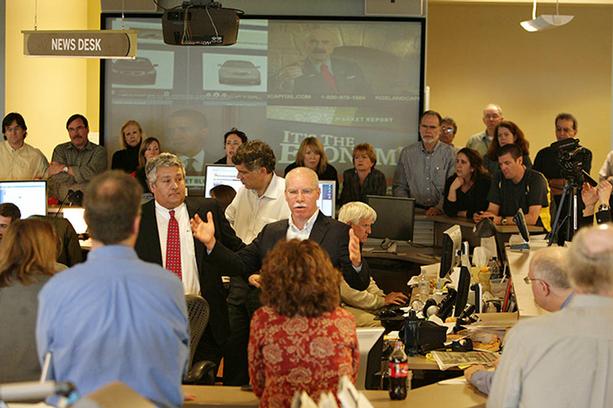 Someone was going to have to step up and reverse the tide of free content, but Newsday?. Owner Cablevision Systems Corp. announced that it’s going to start charging for access to the newspaper’s website and transform it into a “locally focused cable service,” whatever that means. There were few details, but comments from Cablevision executives imply that the revamped Newsday.com will be packaged as a value-added service for cable customers. Ken Doctor thinks the idea is daffy in light of the fact that the average visitor to Newsday.com spends just four-and-a-half minutes there every month.
Someone was going to have to step up and reverse the tide of free content, but Newsday?. Owner Cablevision Systems Corp. announced that it’s going to start charging for access to the newspaper’s website and transform it into a “locally focused cable service,” whatever that means. There were few details, but comments from Cablevision executives imply that the revamped Newsday.com will be packaged as a value-added service for cable customers. Ken Doctor thinks the idea is daffy in light of the fact that the average visitor to Newsday.com spends just four-and-a-half minutes there every month.
But Mark Cuban thinks this is a great idea. The Web 1.0 entrepreneur, who made billions on Broadcast.com, says newspapers should package up their website offerings as a subscription and sell it to cable owners, who will build it into their service fees right next to the Golf Channel. Who’s going to notice an extra 25-cent monthly fee for The New York Times after all? Probably no one, but we question whether a quarter a month from even 100 million subscribers is going to fund the Times’ sprawling news operation. Smaller dailies would see a tiny fraction of that bounty.
Cablevision is no doubt regretting that it ever even heard of Newsday. It paid what is now considered to be a vastly inflated $650 million for Newsday last year. Yesterday, it wrote down $402 million of that cost, pushing itself into the red for the quarter.
Bay Area Agonizes Over Chronicle Woes
![]() New American Media samples the opinions of editors from the ethnic press from around the Bay Area about the impact of the possible closure of the San Francisco Chronicle. The consensus is that it’s very bad news. Many community papers look to the Chron to provide basic city news coverage while their journals pick up the local and ethnic angle. With no major daily in town, editors also wonder how the Bay Area media that’s left is going to keep informed. TV and radio stations, in particular, rely on the daily newspaper to feed them local stories. Most of them are hurting too much to have any hope of filling in the gap that will be left if the newspaper disappears.
New American Media samples the opinions of editors from the ethnic press from around the Bay Area about the impact of the possible closure of the San Francisco Chronicle. The consensus is that it’s very bad news. Many community papers look to the Chron to provide basic city news coverage while their journals pick up the local and ethnic angle. With no major daily in town, editors also wonder how the Bay Area media that’s left is going to keep informed. TV and radio stations, in particular, rely on the daily newspaper to feed them local stories. Most of them are hurting too much to have any hope of filling in the gap that will be left if the newspaper disappears.
Meanwhile, the Chronicle‘s unions are meeting with management about how to achieve the $50 million in cost savings needed to keep the paper afloat. But even massive layoffs don’t solve this structural problem: It costs $10 to produce and deliver a $2 Sunday paper, according to Mother Jones.
By the way, Mark Potts has a great post about the lamentable state of the Chron‘s website as well as the uninspiring condition of newspaper websites in general. He hits the nail on the head in observing that newspaper owners believed from the very beginning that their websites should mimic their newspapers. This completely overlooked the fact that people using browsers have a lot more options than people using newspapers. So why include international news in a local website? He also notes that newspaper home pages are a cacophony of information that confuse and even alienate readers who can easily go somewhere else. Since most people arrive at them via Google anyway, wouldn’t it make more sense to focus the experience on a simplified and more focused individual article page?
Layoff Log
- With the loss of 100 more jobs, including 30 in the newsroom, the Hartford Courant will have effectively cut its news staff by over 40% over the past year. The latest round of layoffs includes shutting down the Courant‘s Washington bureau and reducing the size of its state capitol reporting team by half. The newsroom will be trimmed to 135 people, down from 235 just a year ago.
- Layoffs of 18 more people at the Memphis Commericial Appeal bring to 130 the number of jobs cut since last June, or at least we think it does. We told you that the paper announced 27 layoffs in November, but this Employment Spectator story says the actual number was 57. We agree that 55 people were furloughed last summer, only we reported the news in June while the Employment Spectator says July. The Commercial Appeal definitely employed 700 people before all this cutting began.
- The Augusta (Me.) Chronicle is laying off across “a variety of departments,” according to a statement so devoid of detail that it could have been written in haiku.
- The Buffalo News is considering layoffs because not enough people have taken up management on a buyout offer that includes a lump sum payment of at least $60,000. Go figure.
Miscellany
As part of its exit from the Rocky Mountain area, E.W. Scripps will transfer its 50% stake in the Boulder Camera to MediaNews Group, owner of the Denver Post. The move further consolidates MediaNews CEO Dean Singleton’s hold on the Denver-area news market. Singleton said nothing will change for now, but the company will share some content between the Post and the Camera and will also seek to “create new synergies.” In other words, expect layoffs.
Peter Chianca, a managing editor at GateHouse Media New England, writes a touching elegy for his hometown weekly newspaper, the Putnam County Courier. It was one of scores of local weeklies shuttered by the dying Journal Register Co. two weeks ago. While few people outside of Carmel, N.Y. probably even noticed the loss, Chianca tells of the vital role community weeklies play in doing a thankless task: “keep[ing] people informed about the things that are important to them when they get home at night.”







 Yes we can. We just found it on Twitter. And if you came here looking for breaking news about the latest layoffs and cutbacks, you’re wasting your time. This is a daily blog, which is so last year. Instead, subscribe to
Yes we can. We just found it on Twitter. And if you came here looking for breaking news about the latest layoffs and cutbacks, you’re wasting your time. This is a daily blog, which is so last year. Instead, subscribe to 

